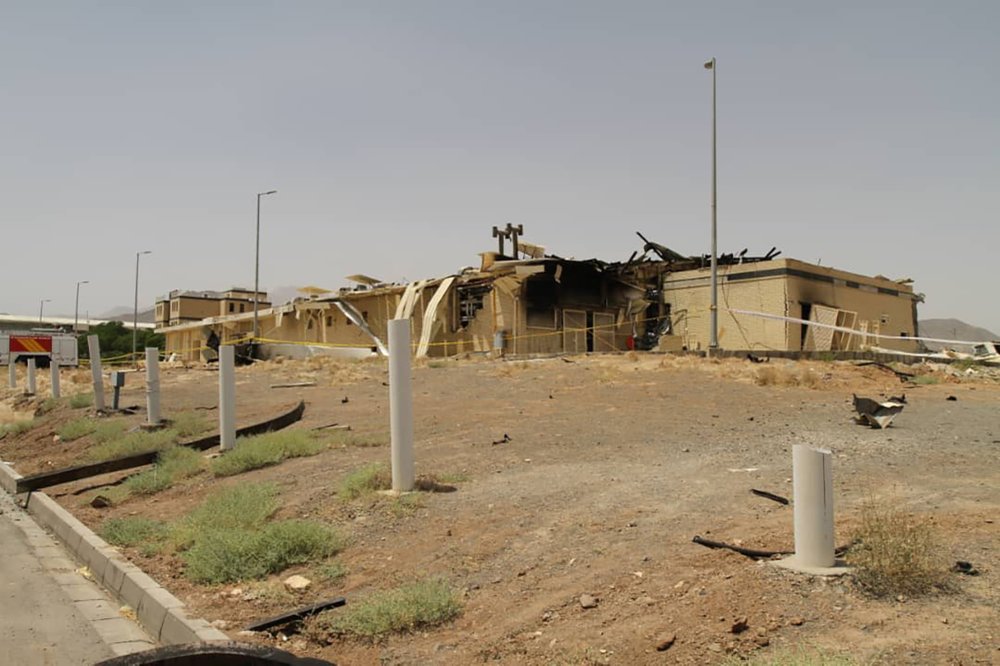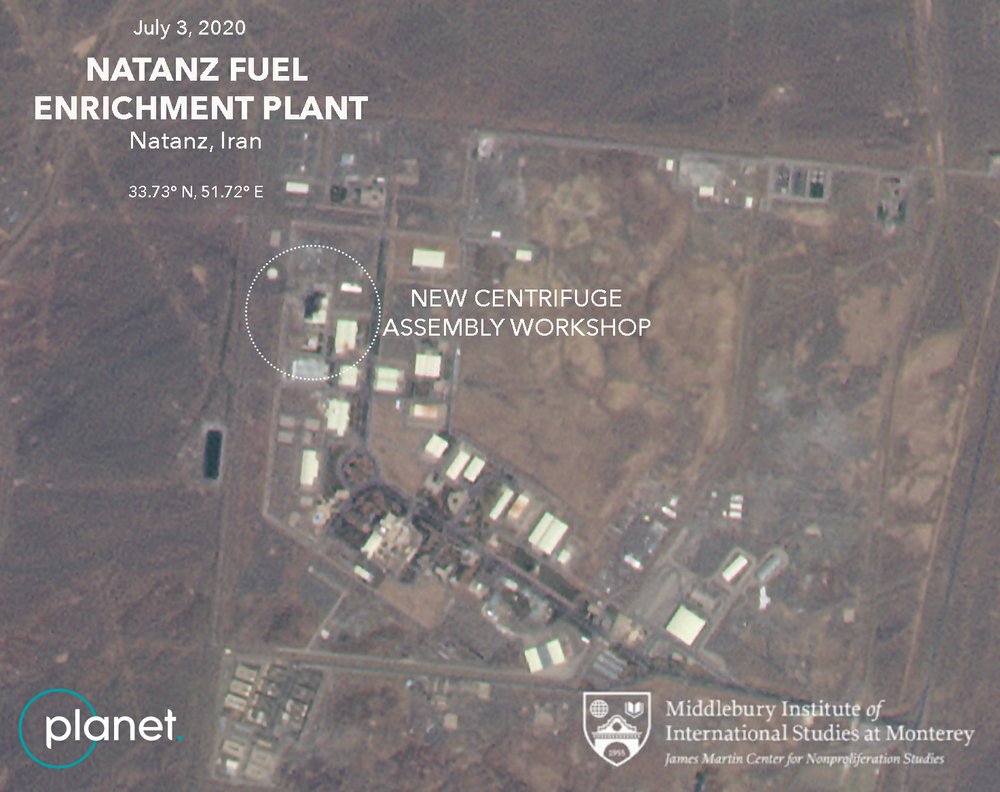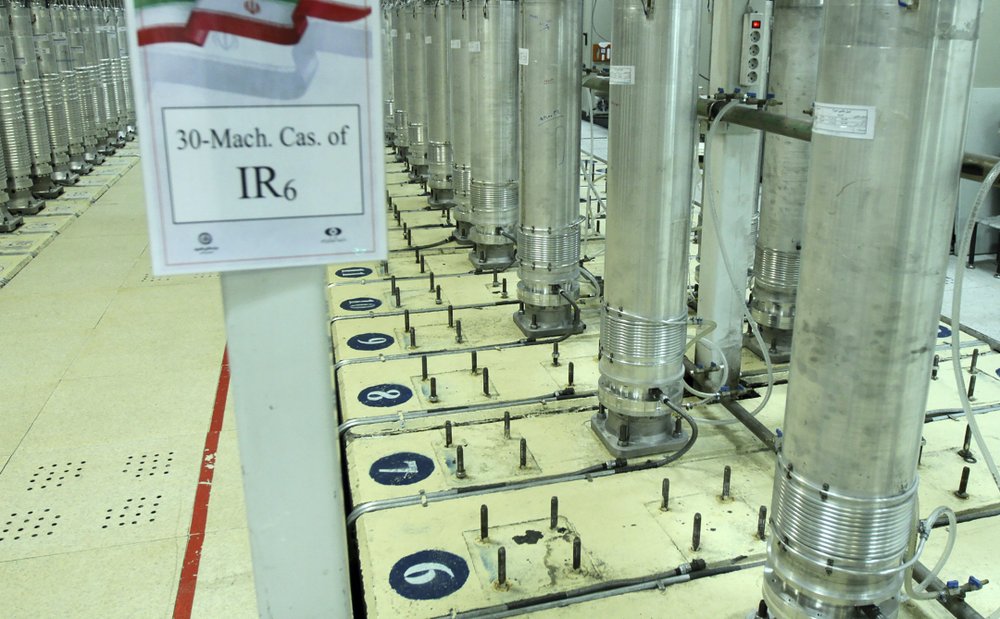An online video and messages purportedly claiming responsibility for a fire that analysts say damaged a centrifuge assembly plant at Iran's underground Natanz nuclear site deepened the mystery Friday around the incident – even as Tehran insisted it knew the cause but would not make it public due to "security reasons."
Early on Thursday, Iran's Atomic Energy Organisation initially reported an "incident" had occurred at Natanz, located in the desert in the central province of Isfahan.
It later published a photo of a one-story brick building with its roof and walls partly burned. A door hanging off its hinges suggested that there had been an explosion inside the building.
A group called "Cheetahs of the Homeland" claimed responsibility for the incidents, posting videos using rhetoric echoes several exiled Iranian opposition organizations. The group also focused almost entirely on Iran's nuclear program, viewed by Israel as a danger to its very existence.

The photo, released by the Atomic Energy Organization of Iran on July 2, 2020, shows a building after it was damaged by a fire, at the Natanz uranium enrichment facility some 200 miles (322 kilometers) south of the capital Tehran, Iran. /AP
The photo, released by the Atomic Energy Organization of Iran on July 2, 2020, shows a building after it was damaged by a fire, at the Natanz uranium enrichment facility some 200 miles (322 kilometers) south of the capital Tehran, Iran. /AP
The disparate messages, as well as the fact that Iran experts have never heard of the group before, raised questions about whether Natanz again had faced sabotage by a foreign nation as it had during the Stuxnet computer virus outbreak believed to have been engineered by the U.S. and Israel.
"If it is proven that our country has been attacked by cyberattacks, we will respond," warned Gen. Gholam Reza Jalali, the head of Iran's military unit in charge of combating sabotage, according to a report late Thursday by the Mizan news agency.
Iranian semiofficial Tasnim news agency quoted the spokesman of Iran's Supreme National Security Council as saying authorities know the cause of the fire.
"Due to some security considerations, the cause and manner of the accident will be announced at the appropriate time," Keyvan Khosravi reportedly said on Friday, without elaborating.
The International Atomic Energy Agency (IAEA) said none of its inspectors were at Natanz at the time of the fire and "that the location where the incident occurred does not contain nuclear materials."
Two U.S.-based analysts told AP that relying on released pictures and satellite images, they identified the affected building as Natanz's new Iran Centrifuge Assembly Center, referring to the delicate cylindrical machines that enrich uranium
A satellite image on Friday by Planet Labs Inc., annotated by experts at the James Martin Center for Nonproliferation Studies at Middlebury Institute of International Studies, shows what appears to be damage done to half of the building.

The satellite image from Planet Labs Inc. annotated by experts at the James Martin Center for Nonproliferation Studies at Middlebury Institute of International Studies shows a damaged building after a fire and explosion at Iran's Natanz nuclear site, on July 3, 2020. /AP
The satellite image from Planet Labs Inc. annotated by experts at the James Martin Center for Nonproliferation Studies at Middlebury Institute of International Studies shows a damaged building after a fire and explosion at Iran's Natanz nuclear site, on July 3, 2020. /AP
Before news of the fire became public Thursday, the BBC's Persian service said its journalists received emails from the self-proclaimed "Cheetahs of the Homeland" claiming an attack at Natanz.
A video claimed the group included "soldiers from the heart of regime's security organizations" who wanted to stop Iran from acquiring a nuclear weapon.
The purported group's name, "the Cheetahs of the Homeland," also struck some as odd, given that "cheetahs" is a nickname for Iran's national football club. Ronen Bergman, an Israeli journalist who works with The New York Times and published a book on the Mossad titled "Rise and Kill First," questioned why an Iranian opposition group would name itself that.
"It's highly unlikely that a serious opposition movement would use such a name, which is probably exactly what the people who came up with it, were aiming people to think," Bergman wrote Friday on Twitter in English, without elaborating. He also tweeted a similar message in Hebrew.
Suspicion over the incident immediately fell on Israel, including in a commentary published by Iran's state-run IRNA news agency Thursday.
Meir Javedanfar, an Iran lecturer at the Interdisciplinary Center in Herzliya, Israel, who viewed the "Cheetahs of the Homeland" video, said any domestic group that managed to penetrate Iran's heavily guarded nuclear facilities would be unlikely to risk being captured by distributing such a video. He said "it's difficult to know" if Israel's Mossad or another foreign intelligence agency produced the video.
"It could be a foreign intelligence agency, in order to sow discord in Iran ... or maybe it's a false flag by the Iranian regime in order to crack down," Javedanfar said.
The video did, however, call it the Kashan nuclear site, rather than Natanz. Kashan is a nearby city once home to a large, historic Jewish community. Iranians uniformly call the nuclear site Natanz.

File photo: This photo released by the Atomic Energy Organization of Iran on November 5, 2019, shows centrifuge machines in the Natanz uranium enrichment facility in central Iran. /AP
File photo: This photo released by the Atomic Energy Organization of Iran on November 5, 2019, shows centrifuge machines in the Natanz uranium enrichment facility in central Iran. /AP
Destroying a centrifuge assembly facility could greatly impact Iran's ability to quickly enrich greater amounts of uranium, which would be a goal for either Israel or the U.S.
Iran had begun experimenting with advanced centrifuge models in the wake of the U.S. unilaterally withdrawing two years ago from Tehran's 2015 nuclear deal with world powers. However, it took years for Iran to perfect its first-generation IR-1 centrifuge off designs it purchased from Pakistani scientist A.Q. Khan's black market network. It's unclear if Iran has another similar-size assembly facility.
The fact that the Natanz fire comes less than a week after an explosion in an area east of Tehran that analysts believe hides an underground tunnel system and missile production sites also raises suspicions.
The Texas-based private intelligence firm Stratfor said either incident could "have been the result of a domestic group acting with or without foreign support, or the result of a U.S. or Israeli cyber attack."
"If there is a campaign by the United States, Israel and/or local groups in Iran underway, then Iran is likely to eventually respond in kind, potentially against Western targets in the Persian Gulf," Stratfor warned.
(With input from AP)